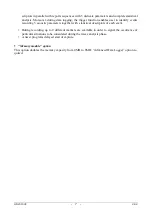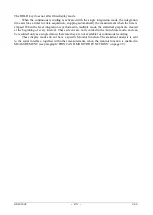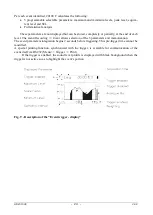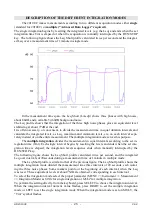
HD2010UC
- 15 -
V4.2
The “analogue bar” shows the unweighted sound pressure instantaneous level in an 80 dB in-
terval.
Three measuring parameters are displayed under the analogue bar. All displayed parameters can be
freely selectable among the available ones. There are no restrictions in the selection of frequency
weightings. Measuring parameters are displayed with a shortened label, followed by the numerical
value, by the unit of measurement, and, when necessary, by the frequency weighting. The corre-
spondence between the label and the effective parameter is to be found on page 99.
Integrated parameters like Leq (and Lmax or Lmin), which imply the accumulation of the sampled
sound levels, are displayed with a series of dashes (----) until the level remains lower than the min-
imum measurable level.
Before starting a new logging, the sound level meter automatically resets all measurements. If
the multiple integration mode is enabled (MENU >> Instrument >> Measurements >> Integration
Mode: MULT), integrated levels will be automatically set to zero at regular intervals equal to the
set integration time
Tint
.
If the “Advanced Data Logger” option is installed, with the
Continuous Recording
mode a se-
ries of values is stored every 0.5s together with the parameter displayed in the PROFILE screen,
which corresponds to the A weighted sound pressure level with FAST time constant, computed 8
times a second. Each sample corresponds to the highest sound level (L
AFmx
) calculated every 0.125s
on the level measured every 7.8ms.
S
ELECTING
P
ARAMETERS
Some measuring parameters (integration interval, measuring range and the 3 parameters) can
be changed directly via the SLM screen.
Pressing SELECT you choose the different parameters in sequence. While the selected parameter
flashes, you can change it with the UP and DOWN keys.
If a parameter with attribute is selected, like, for example, LFp (FAST weighted pressure lev-
el), the relative frequency weighting will also flash (A in the example in the figure). In this case,
pressing UP and DOWN, you can modify the selected parameter without changing the attribute; for
example, if you press DOWN, you can go from LFp A weighted to LSp A weighted. Pressing
RIGHT you’ll jump to the attribute selection, which will be the only one to flash. Use then the UP
and DOWN keys to change the attribute. For example, if you press UP, you can go from A
weighted LSp to Z weighted LSp.
Pressing SELECT let you choose the next parameter; pressing ENTER, or automatically after
approximately 10s, will let you exit the selection mode.
Also the
integration mode
(see page 25) can be set using the LEFT and RIGHT keys: press
SELECT to choose the integration interval. When the integration interval numeric value flashes,
press RIGHT to set the
multiple
integration mode or LEFT to set the
single
integration mode. When
the integration mode is set on MULT, the “Tint” symbol flashes.
Parameters can be modified only when the instrument is in STOP mode
: if you try to
make changes to any of the parameters while the instrument is in a status other than STOP, you will
be asked to stop the measurement in progress: pressing YES will stop recording and will allow you
to go on modifying parameters; pressing NO recording will continue without interruption.
The above settings can be made through the instrument configuration menus. See a detailed descrip-
tion on page.32.
B
ACK
-E
RASE
F
UNCTION
(
DATA EXCLUSION
)
To stop a measurement in progress when recording, press the
PAUSE/CONTINUE
key.
All data logged until the moment key was pressed are used for calculation of integrated pa-
rameters. However, there are some cases when it is useful to clear the measurements recorded just
Summary of Contents for DeltaOHM HD2010UC
Page 2: ...HD2010UC 2 V4 2 ...
Page 129: ...HD2010UC 129 V4 2 NOTES ...
Page 130: ...HD2010UC 130 V4 2 NOTES ...
Page 131: ......
















































